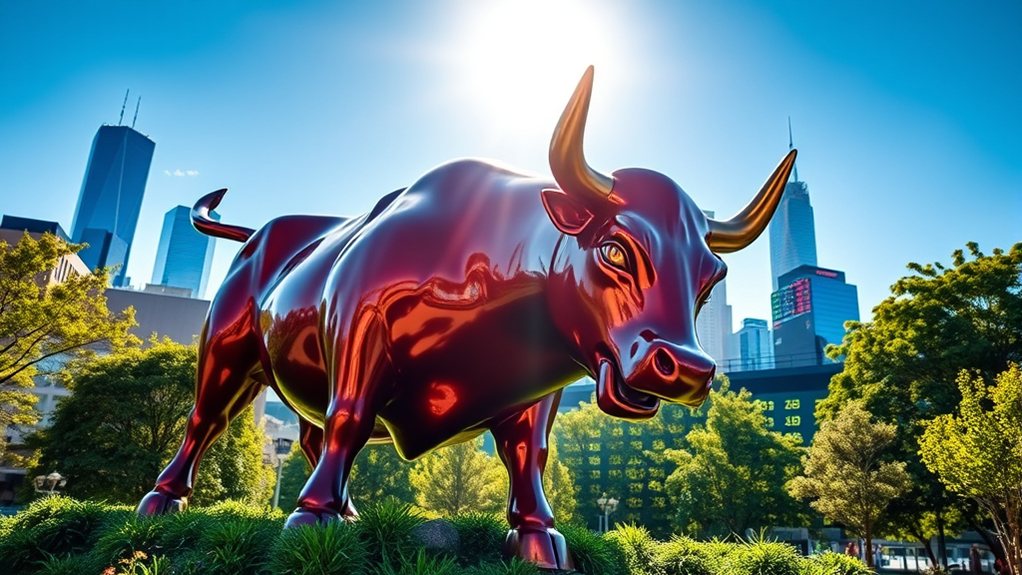A bull market occurs when stock prices rise by at least 20% from recent lows. It's marked by high investor confidence, strong economic growth, and increasing company profits. These upward trends typically last about 4.9 years, with the longest U.S. bull market stretching for 11 years (2009-2020). During these periods, unemployment falls, wages improve, and more companies go public. The details reveal fascinating patterns in market behavior.

Optimism fills the air during a bull market, a period when stock prices rise steadily over time. This financial phenomenon is technically defined as a 20% increase from recent market lows. The term "bull market" comes from the way a bull attacks, thrusting its horns upward, which mirrors the upward trend of stock prices during these periods. While most commonly associated with stocks, bull markets can occur in any asset class, including bonds, real estate, and commodities.
Bull markets symbolize optimism through rising prices, named for the upward thrust of a bull's horns.
Bull markets display several distinctive characteristics. Investor confidence runs high, with many people enthusiastic to buy stocks in anticipation of further gains. Economic indicators typically show strength, including robust GDP growth and low unemployment rates. Companies report increasing profits, and consumers spend more freely. Business investment also tends to climb during these optimistic times.
The duration of bull markets varies considerably. On average, they last about 4.9 years, though some are much shorter or longer. The longest bull market in U.S. history ran from 2009 to 2020, lasting approximately 11 years before the COVID-19 pandemic ended it. Bull markets typically last longer than bear markets, allowing investors to recoup losses experienced during downturns. It's worth mentioning that bull markets can only be definitively identified after they've ended, as the exact peak is difficult to spot in real time.
History provides several significant examples of bull markets. The 1990s saw an extraordinary run that delivered a 417% return before ending in 2000. Other prominent bull markets include the 2003-2007 period, the post-Great Depression rally from 1932-1937, and the post-World War II expansion from 1949-1956.
The economic impact of bull markets extends beyond Wall Street. They often coincide with broader economic expansions, featuring increased job creation, higher wages, and lower unemployment. Companies find it easier to raise capital, leading to more initial public offerings (IPOs). Corporate earnings typically grow, benefiting both businesses and their shareholders.
During bull markets, investors often adopt different strategies. Many embrace a buy-and-hold approach, maintaining positions for long-term growth. Supportive monetary policies, especially low interest rates, tend to fuel these extended upward trends by making borrowing cheaper for businesses and consumers alike. Risk tolerance tends to increase, sometimes leading to more speculative investments. Growth stocks frequently outperform value stocks during these periods, prompting some investors to adjust their portfolios accordingly.
Despite their positive nature, bull markets come with risks. Markets can become overvalued, potentially creating bubbles that eventually burst. Even within strong bull markets, corrections of 10-20% can occur temporarily. As bull markets mature, they often experience increased volatility. Psychological factors like fear of missing out can drive investor behavior, sometimes leading to irrational decisions.
When the inevitable downturn arrives, it marks the end of the bull market and the beginning of its opposite: a bear market.
Frequently Asked Questions
How Long Do Bull Markets Typically Last?
Bull markets typically last between 3.8 years (1,011 days) on average, with a median duration of 2.7 years (992 days).
They're about 3.5 times longer than bear markets. The longest bull market stretched for 11 years from 2009 to 2020.
Since 1928, there have been 26-27 bull markets in total. Most bull markets deliver significant gains, with average cumulative returns between 114.9% and 149.2%.
Can Individual Sectors Experience Bull Markets During Overall Market Downturns?
Yes, individual sectors can experience bull markets during broader market downturns. This phenomenon occurs when specific industries show strength despite overall negative trends.
Defensive sectors like utilities, healthcare, and consumer staples often rally during recessions. For example, technology stocks performed well during parts of the 2000-2002 bear market, while energy stocks outperformed during the 2008 financial crisis.
These sector-specific bull runs can last for weeks, months, or even years.
What Indicators Predict the End of a Bull Market?
Several indicators can signal a bull market's end. These include high P/E ratios, an inverted yield curve, and the Buffett Indicator exceeding 120%.
Technical signs like the death cross and RSI above 70 also warn of trouble.
Declining economic data, including three consecutive drops in the Leading Economic Index, often precede downturns.
Extreme optimism shown by low VIX readings, high margin debt, and increased retail participation typically appears before market peaks.
Do International Markets Follow Similar Bull Market Patterns?
International markets often follow similar bull market patterns to the U.S., but with variations. Developed markets typically move in tandem, showing increased correlation since the 2008 financial crisis.
European markets usually lag U.S. bull markets by 3-6 months. Emerging markets follow general trends but with less correlation.
Regional differences exist due to local economic conditions, central bank policies, commodity dependencies, and currency fluctuations.
Technology and globalization have strengthened these connections through increased cross-border capital flows.
How Should Retirement Strategies Adjust During Bull Markets?
During bull markets, retirement strategies typically shift.
Investors often rebalance portfolios by selling some high-performing stocks. They then reinvest these profits in more stable options.
Some people take this chance to maximize retirement account contributions. Financial experts say it's important not to get caught up in market excitement.
Many retirees use this time to build cash reserves that can protect them when markets eventually decline.










